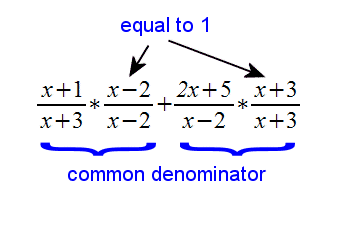Adding and Subtracting Rational Functions
What is a rational function again?
As a reminder, a rational function is an expression formed by dividing two polynomial functions. For example, the following is a rational function:
$$ f(x)=\frac{4x+4}{6x-9} $$
How do we add or subtract them?
When adding or subtracting rational functions, you must find a common denominator as you might do with regular fractions. For example, to add \(\frac{1}{2}\) and \(\frac{1}{3}\), you might do the following:
The original fractions: $$ \frac{1}{2}+\frac{1}{3} $$
with a common denominator: $$ \frac{2}{6}+\frac{3}{6} $$
result: $$ \frac{5}{6} $$
Now, let's apply this same strategy to the addition and subtraction of rational functions:
$$ \frac{x+1}{x+3}+\frac{2x+5}{x-2} = ?? $$
Step 1
Find a common denominator by multiplying the denominators. So, \((x + 3)(x - 2)\) becomes our common denominator in this case. Then, multiply each fraction by something equivalent to "1" (which of course doesn't change the actual value!), such as \(\frac{x+3}{x+3}\), to get each fraction in terms of that common denominator:

Step 2
Now, multiply out (expand) the top and we will be ready to add the two fractions:
$$ \frac{(x+1)(x-2)}{(x+3)(x-2)}+\frac{(2x+5)(x+3)}{(x+3)(x-2)} $$
$$ \frac{x^2-2x+x-2}{(x+3)(x-2)}+\frac{2x^2+6x+5x+15}{(x+3)(x-2)} $$
Step 3
Add the numerators just like you would with two simple fractions:
$$ \frac{3x^2+10x+13}{(x+3)(x-2)} $$
The Result
Finally, we probably want to expand the denominator as well to give us the resulting rational function:
$$ \frac{3x^2+10x+13}{x^2+x-6} $$
And that's our answer!
NOTE: To subtract rational functions, follow the same steps that you used to add rational functions, but just subtract the numerators instead of adding them!
For information on rational functions, try a search on Google or this lesson on rational functions.
By Mr. Feliz and Free Math Help
